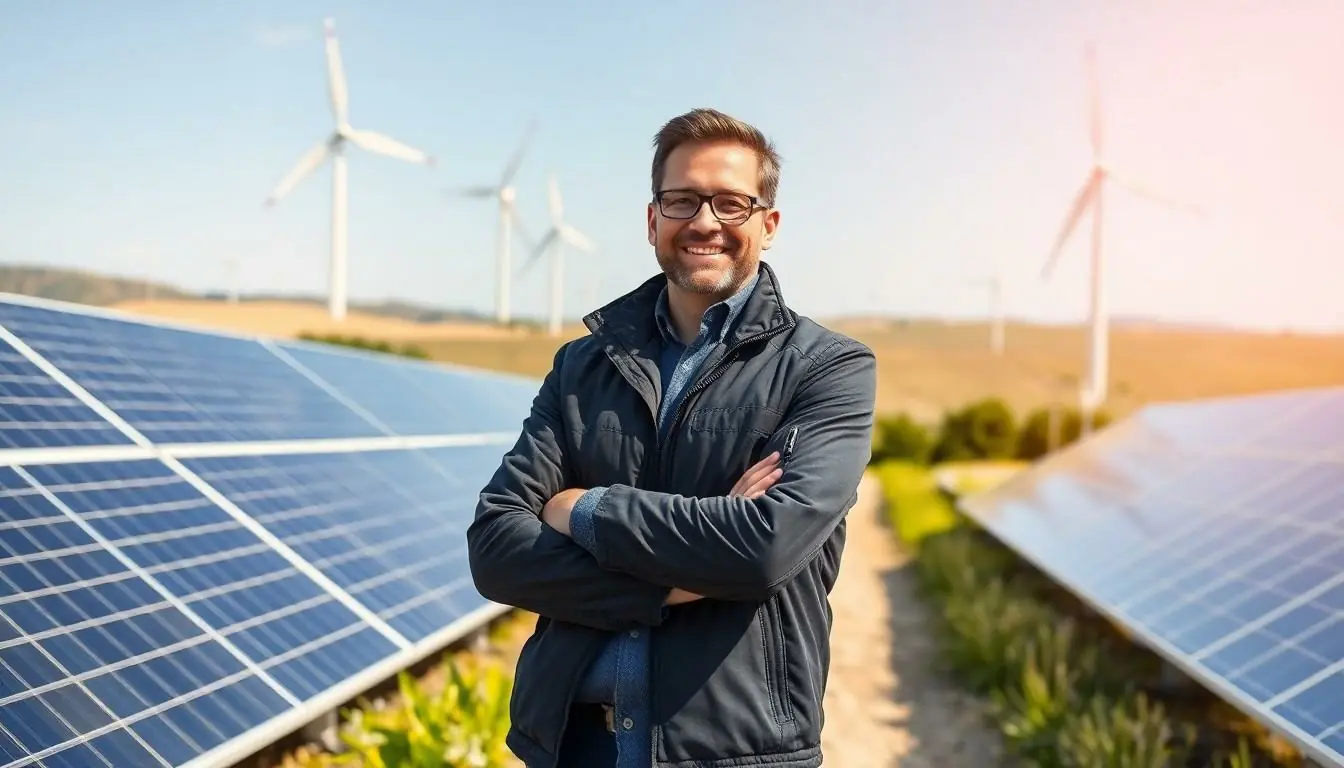In a world where fossil fuels are about as popular as a flat tire, renewable energy icons are stepping into the spotlight like rock stars at a sold-out concert. These trailblazers are not just saving the planet; they’re making sustainability look cool. From wind turbines that dance in the breeze to solar panels soaking up the sun’s rays, they’re proving that going green can be both chic and effective.
As climate change becomes a hot topic—pun intended—these renewable energy champions are leading the charge toward a cleaner, brighter future. They’re not just icons; they’re the superheroes we didn’t know we needed. With innovation and a touch of humor, they’re transforming our energy landscape one gigawatt at a time. Buckle up as we explore the inspiring stories behind these renewable energy icons and discover how they’re changing the game for good.
Table of Contents
ToggleOverview of Renewable Energy
Renewable energy refers to energy sourced from naturally replenishing resources. This includes solar, wind, hydroelectric, geothermal, and biomass energy. Solar energy generates power through sunlight, while wind energy harnesses wind currents via turbines. Hydroelectric energy utilizes flowing water’s kinetic energy to produce electricity. Geothermal energy taps into the Earth’s internal heat, and biomass energy derives from organic materials.
The global shift towards renewable energy stems from the urgent need to reduce greenhouse gas emissions. According to the International Renewable Energy Agency, renewable sources contributed 29% of global power generation in 2020. Progress in renewable technologies leads to decreased dependency on fossil fuels. Enhanced efficiency in solar panels and wind turbines further supports this transition.
Investments in renewable energy sectors are increasing significantly. The United Nations reported that $282 billion flowed into renewable energy technologies in 2019. Job creation remains a key benefit of the renewable sector, with approximately 11.5 million people employed globally in renewables by 2018. Nations prioritizing renewable energy demonstrate economic growth in energy innovation.
Public awareness about climate change and its impacts fuels demand for cleaner energy alternatives. Audiences engage with compelling stories of individuals and organizations advancing renewable initiatives. Icons of renewable energy inspire communities, emphasizing the importance of sustainability in daily life. They advocate for policies that support clean energy and promote a greener future.
Overall, renewable energy poses a viable solution for a more sustainable and environmentally conscious world. Innovations and public engagement will continue to drive the renewable energy movement forward.
Importance of Renewable Energy Icons

Renewable energy icons play a crucial role in promoting sustainable solutions and motivating action toward cleaner energy sources. Their influence extends beyond simple recognition, embodying the values of innovation and commitment to environmental stewardship.
Symbolic Representation
Symbols associated with renewable energy convey powerful messages. They embody hope for a sustainable future while emphasizing the urgent need for change. Visual elements like the wind turbine or solar panel often serve as reminders of the transition from fossil fuels to renewable sources. Each icon resonates with communities, inspiring collective efforts toward cleaner energy solutions. Such imagery builds a shared identity among advocates, making sustainable practices more relatable and widely accepted.
Impact on Public Awareness
Icons of renewable energy significantly enhance public awareness of environmental issues. They capture attention and generate interest, driving conversations about sustainability. Engaging graphics and memorable symbols make complex concepts more accessible. When people see these icons, they associate them with progress and innovation. Engaging campaigns often highlight stories of renewable energy champions, encouraging others to take part in eco-friendly initiatives. This rise in visibility fosters a sense of community, motivating individuals to embrace cleaner energy options and support policies that promote sustainability.
Notable Renewable Energy Icons
Renewable energy icons play vital roles in fostering sustainability. Their efforts inspire change and promote cleaner alternatives to fossil fuels.
Individuals Who Pioneered Change
Some individuals have made significant contributions to the renewable energy movement. Elon Musk has spearheaded advancements in solar technology and electric vehicles through Tesla. Dr. Wangari Maathai, a Nobel Laureate, mobilized communities in Kenya for sustainable land practices and tree planting. Additionally, Bill McKibben founded 350.org to advocate for global climate action. These leaders demonstrate how individual commitment can drive widespread change and raise awareness about the importance of renewable resources.
Organizations Leading the Charge
Several organizations have emerged as champions in renewable energy advocacy. The International Renewable Energy Agency (IRENA) supports countries in their transition toward sustainable energy, providing data and policy advice. Greenpeace campaigns for clean energy solutions while raising public awareness about environmental issues. The Rocky Mountain Institute focuses on energy efficiency and economic strategies to reduce reliance on fossil fuels. Collaboratively, these organizations mobilize resources and engage communities, pushing the boundaries of renewable energy adoption on a global scale.
Challenges Faced by Renewable Energy Icons
Renewable energy icons confront several significant challenges in their mission to promote sustainable energy solutions. These obstacles range from technological limitations to political and economic dynamics.
Technological Barriers
Technological barriers hinder the widespread adoption of renewable energy. Inconsistent energy outputs from sources like solar and wind require advancements in energy storage solutions. Limited infrastructure in some regions can restrict access to renewable technologies. Research and development efforts need to focus on improving efficiency and reducing costs of renewable systems. Also, integrating renewable sources into existing grids remains a complex issue, complicating the transition to cleaner energy.
Political and Economic Factors
Political and economic factors significantly impact renewable energy initiatives. Government policies often prioritize fossil fuels over renewables, creating an uneven playing field. Economic incentives for clean energy solutions are not universally available, which can deter investment. Market fluctuations can affect the financial viability of renewable projects. Furthermore, lobbying pressures from established energy sectors may stall progressive legislation. Thus, a cohesive approach involving policymakers and stakeholders is essential for overcoming these hurdles.
Future of Renewable Energy Icons
The future of renewable energy icons looks promising as advancements in technology continue to reshape the energy landscape. Increased efficiency in solar panel production and wind turbine design drives down costs, making renewable energy more accessible. As of 2020, renewable sources produced 29% of global power generation, highlighting their growing significance in the energy sector.
Notable figures like Elon Musk and organizations such as IRENA lead the charge in innovation and policy advocacy. Their efforts showcase the potential impact of strong leadership on renewable energy adoption. Engaging storytelling and visibility surrounding renewable energy icons create enthusiasm and community involvement.
A growing public awareness around climate change fuels demand for sustainable solutions. Individuals and institutions are inspired by campaigns featuring renewable energy champions that advocate for cleaner initiatives. Enhanced visual symbols, such as solar panels and wind farms, solidify a collective identity committed to environmental stewardship.
Political and economic factors pose ongoing challenges for renewable energy icons. Government policies that favor fossil fuels can hinder progress toward sustainable energy solutions. Collaborative approaches involving multi-stakeholder engagement will be crucial in overcoming these barriers.
Job creation in the renewable energy sector exemplifies its economic potential. Approximately 11.5 million people were employed in the global renewable energy workforce by 2018, showcasing the sector’s capacity for growth. Such statistics prompt continued investment and innovation in renewable technologies.
Overall, the presence of renewable energy icons is vital for guiding society toward an environmentally conscious future. Their influence encourages ongoing dialogue and action, fostering a culture centered on sustainability and resilience.
The impact of renewable energy icons is profound and far-reaching. They not only symbolize hope and innovation but also inspire collective action toward a cleaner future. As society navigates the complexities of climate change, these champions continue to advocate for sustainable solutions and engage communities in meaningful ways.
Their efforts highlight the importance of transitioning to renewable sources, which can lead to job creation and economic growth. While challenges remain, the ongoing advancements in technology and public awareness signal a promising path forward. Embracing renewable energy is essential for building a resilient and environmentally conscious world.





